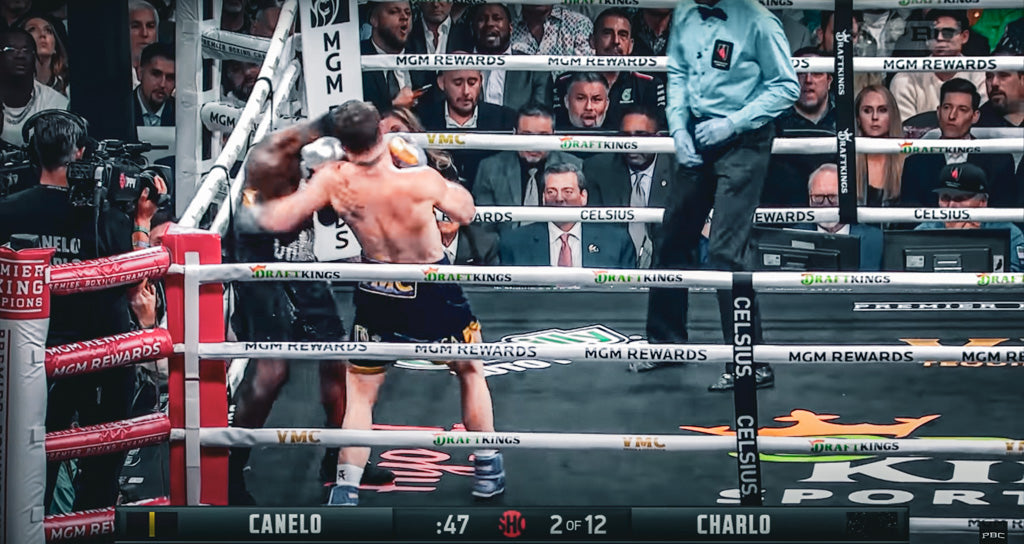
“Squish the Bug: The Great Pivot Debate in Boxing”
Share
By: Coach Jus
Scroll through any boxing forum long enough and you'll find them—the pivot truthers and the flat-foot defenders, each certain they've cracked the code. I've watched countless threads devolve into screenshots of Canelo Alvarez's lead hook and grainy stills of Mike Tyson mid-punch, all to answer one deceptively simple question: Should you pivot your foot for the lead hook?
The Kinetic Chain: Boxing's Power Secret
Power doesn't start in your fist. It travels up from the ground—foot to ankle to knee to hip to torso to shoulder and finally into your knuckles. This sequence is what we call the kinetic chain.
When your chain clicks, you know it. That perfect cross that barely felt like you threw it, but somehow echoed through the heavy bag. That hook that made your sparring partner's eyes widen. But when the chain breaks? You're arm-punching, pushing shots, and feeling it in your shoulder the next day.
Two Schools of Thought
Team Pivot lives by rotation. They'll tell you that turning on the ball of your foot—whether it's the back foot on a cross or the lead foot on a hook—unlocks your hips, which is where real power originates. You might hear a coach holler "Squish the bug!", a reminder to twist that foot like you're crushing a cigarette.
Team Flatfoot counters that excessive pivoting compromises balance and position. They argue that staying grounded, especially in exchanges, provides the stability needed for defense and quick counters. Why spin yourself out of position just to add marginal power?
Each side has their highlight reels and slow-motion examples. So who's right?
The Middle Path
After 20+ years in the sport, I've learned this much: context matters.
When I was rebuilding myself at Wild Card, I had two trainers giving me advice. Eric would slap my shoulder if I threw a cross without pivoting my back foot. "Squish the bug, damn it!" Meanwhile, Welch would say, "Do it, and don't do it."
His wisdom stuck with me. Sometimes the pivot gives you what you need—rotational power, proper alignment, full extension. Other times, it takes you out of position when you need to stay rooted.
When to Pivot:
- For long-range power shots where you have time and space
- When throwing combinations that flow from one side to another
- To generate maximum torque on single power punches
- To shift your angle after an attack
When to Stay Flat:
- In the pocket, where stability trumps maximum power
- When you need to immediately counter after your punch
- Against pressure fighters who'll exploit any positional weakness
- When setting traps that require subtle weight shifts
Beyond Mechanics: The Nervous System Connection
What's fascinating is how this debate has evolved with our understanding of the body. It's not just about muscles and bones anymore.
The fascial system—that web of connective tissue throughout your body—responds to rotational movement in ways we're only beginning to understand. A proper pivot doesn't just turn your foot; it creates a spiral tension pattern that runs through your entire kinetic chain. Your nervous system learns this pattern through repetition.
But that same nervous system also craves stability in threatening situations. When an opponent is throwing back, your body might instinctively prioritize balance over maximum rotation. This might explain why even pivot devotees often plant their feet when the exchanges get heated.
Finding Your Way
I've learned to approach this question with curiosity rather than dogma. I watch how my body naturally wants to move. I experiment with different techniques for different situations. And most importantly, I pay attention to results.
Some of my hardest punches come with a textbook pivot. Some of my most effective combinations come with subtle or minimal foot rotation. Both have their place in a complete fighter's arsenal.
The next time someone insists there's only one correct answer to the pivot question, remember: boxing is a conversation between bodies, not a recitation of rules. The best technique is the one that works for you, in that moment, against that opponent.
What's your experience with the pivot? Drop a comment below.
